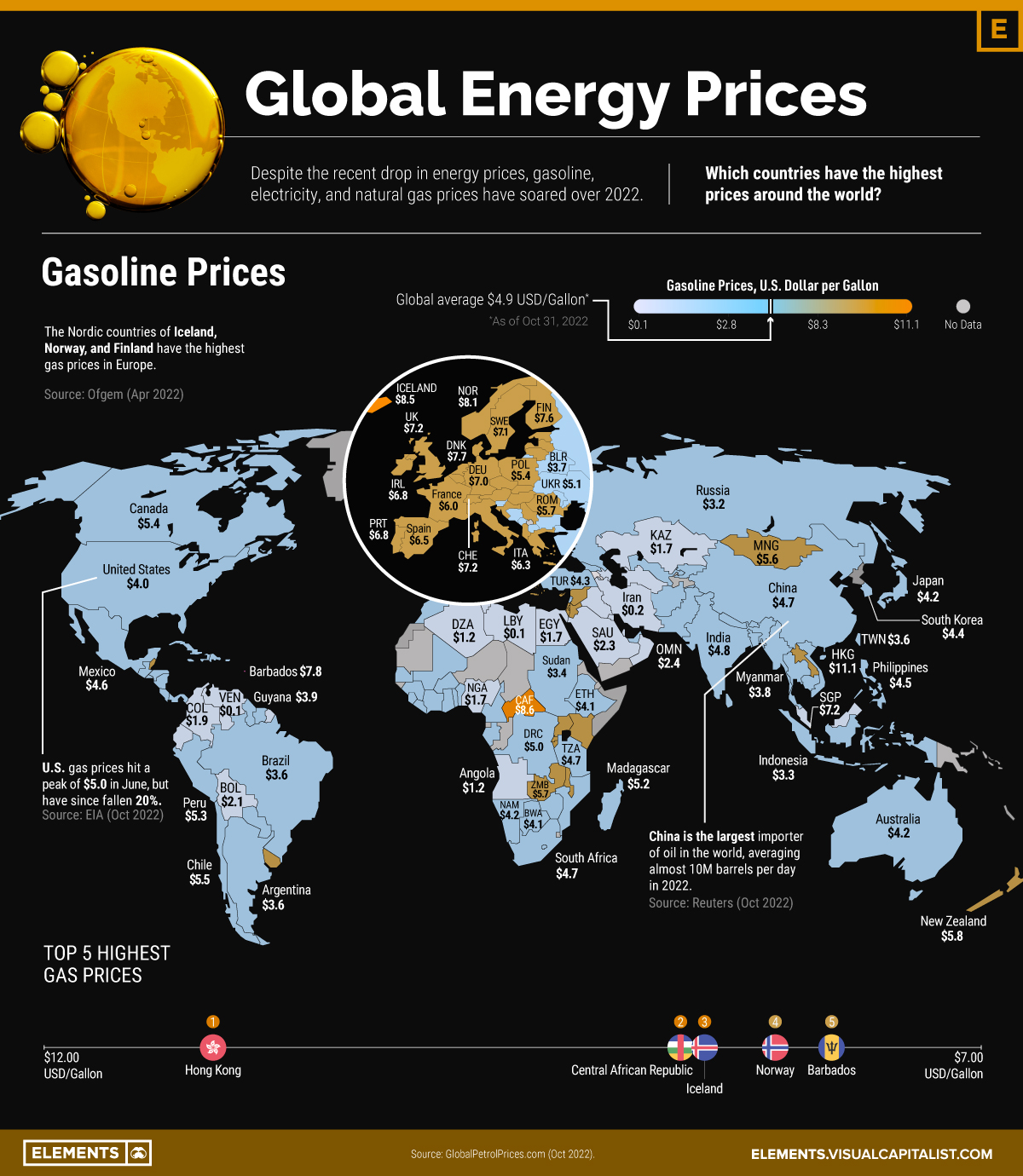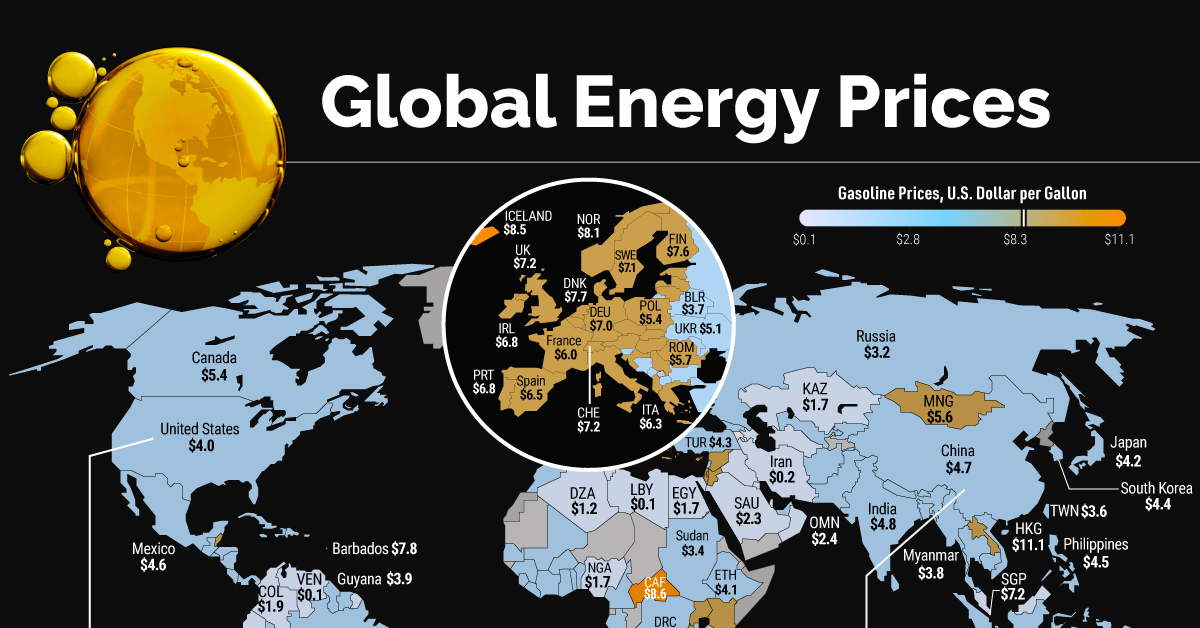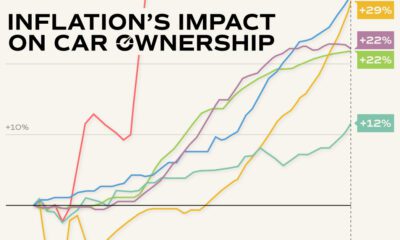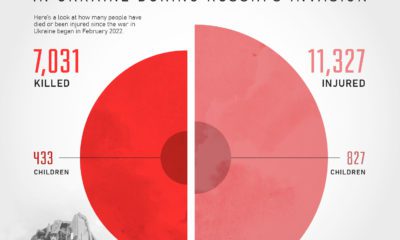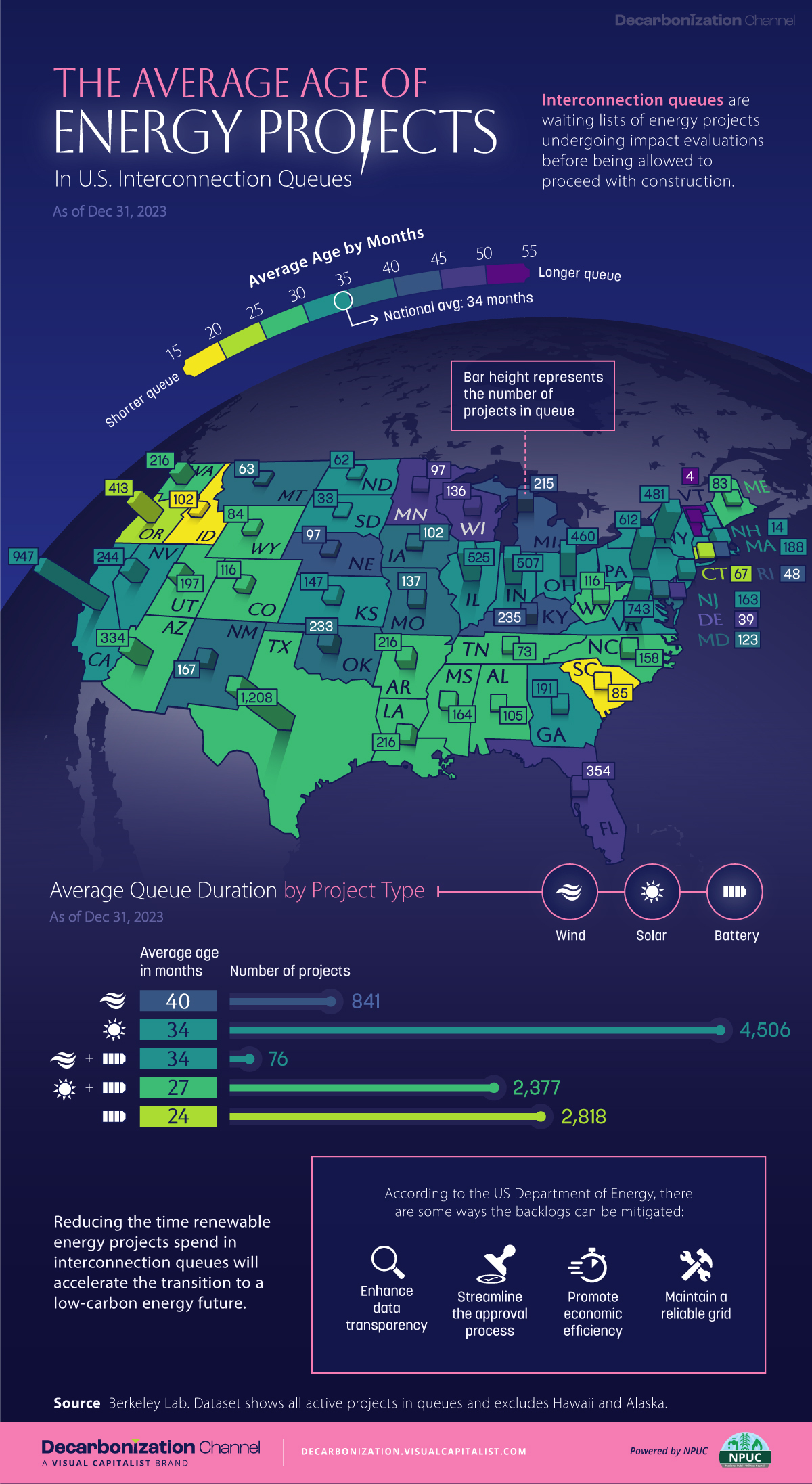Energy
Mapped: Global Energy Prices, by Country in 2022
How to use: Arrows on side navigate between each type of energy.
Mapped: Global Energy Prices, by Country in 2022
This was originally posted on Elements. Sign up to the free mailing list to get beautiful visualizations on natural resource megatrends in your email every week.
For some countries, energy prices hit historic levels in 2022.
Gasoline, electricity, and natural gas prices skyrocketed as Russia’s invasion of Ukraine ruptured global energy supply chains. Households and businesses are facing higher energy bills amid extreme price volatility. Uncertainty surrounding the war looms large, and winter heating costs are projected to soar.
Given the global consequences of the energy crisis, the above infographic shows the price of energy for households by country, with data from GlobalPetrolPrices.com.
1. Global Energy Prices: Gasoline
Which countries and regions pay the most for a gallon of gas?
| Rank | Country/ Region | Gasoline Prices (USD per Gallon) |
|---|---|---|
| 1 | 🇭🇰 Hong Kong | $11.1 |
| 2 | 🇨🇫 Central African Republic | $8.6 |
| 3 | 🇮🇸 Iceland | $8.5 |
| 4 | 🇳🇴 Norway | $8.1 |
| 5 | 🇧🇧 Barbados | $7.8 |
| 6 | 🇩🇰 Denmark | $7.7 |
| 7 | 🇬🇷 Greece | $7.6 |
| 8 | 🇫🇮 Finland | $7.6 |
| 9 | 🇳🇱 Netherlands | $7.6 |
| 10 | 🇧🇪 Belgium | $7.4 |
| 11 | 🇬🇧 United Kingdom | $7.2 |
| 12 | 🇪🇪 Estonia | $7.2 |
| 13 | 🇨🇭 Switzerland | $7.2 |
| 14 | 🇸🇬 Singapore | $7.2 |
| 15 | 🇸🇪 Sweden | $7.1 |
| 16 | 🇸🇨 Seychelles | $7.1 |
| 17 | 🇮🇱 Israel | $7.0 |
| 18 | 🇩🇪 Germany | $7.0 |
| 19 | 🇺🇾 Uruguay | $7.0 |
| 20 | 🇼🇫 Wallis and Futuna | $7.0 |
| 21 | 🇱🇮 Liechtenstein | $6.9 |
| 22 | 🇮🇪 Ireland | $6.8 |
| 23 | 🇵🇹 Portugal | $6.8 |
| 24 | 🇱🇻 Latvia | $6.7 |
| 25 | 🇧🇿 Belize | $6.7 |
| 26 | 🇦🇱 Albania | $6.6 |
| 27 | 🇦🇹 Austria | $6.6 |
| 28 | 🇲🇨 Monaco | $6.6 |
| 29 | 🇪🇸 Spain | $6.5 |
| 30 | 🇨🇿 Czech Republic | $6.5 |
| 31 | 🇲🇼 Malawi | $6.5 |
| 32 | 🇰🇾 Cayman Islands | $6.4 |
| 33 | 🇸🇰 Slovakia | $6.4 |
| 34 | 🇲🇺 Mauritius | $6.3 |
| 35 | 🇱🇺 Luxembourg | $6.3 |
| 36 | 🇱🇹 Lithuania | $6.3 |
| 37 | 🇦🇩 Andorra | $6.3 |
| 38 | 🇮🇹 Italy | $6.3 |
| 39 | 🇺🇬 Uganda | $6.2 |
| 40 | 🇭🇺 Hungary | $6.2 |
| 41 | 🇯🇴 Jordan | $6.2 |
| 42 | 🇸🇾 Syria | $6.1 |
| 43 | 🇫🇷 France | $6.0 |
| 44 | 🇧🇮 Burundi | $6.0 |
| 45 | 🇧🇸 Bahamas | $6.0 |
| 46 | 🇳🇿 New Zealand | $5.8 |
| 47 | 🇸🇲 San Marino | $5.8 |
| 48 | 🇭🇷 Croatia | $5.8 |
| 49 | 🇷🇴 Romania | $5.7 |
| 50 | 🇾🇹 Mayotte | $5.7 |
| 51 | 🇷🇼 Rwanda | $5.7 |
| 52 | 🇿🇲 Zambia | $5.7 |
| 53 | 🇷🇸 Serbia | $5.7 |
| 54 | 🇱🇦 Laos | $5.6 |
| 55 | 🇲🇳 Mongolia | $5.6 |
| 56 | 🇰🇪 Kenya | $5.6 |
| 57 | 🇨🇾 Cyprus | $5.6 |
| 58 | 🇯🇲 Jamaica | $5.5 |
| 59 | 🇲🇰 Northern Macedonia | $5.5 |
| 60 | 🇨🇱 Chile | $5.5 |
| 61 | 🇧🇦 Bosnia | $5.5 |
| 62 | 🇱🇨 Saint Lucia | $5.4 |
| 63 | 🇵🇱 Poland | $5.4 |
| 64 | 🇩🇴 Dominican Republic | $5.4 |
| 65 | 🇨🇦 Canada | $5.4 |
| 66 | 🇲🇦 Morocco | $5.4 |
| 67 | 🇦🇼 Aruba | $5.4 |
| 68 | 🇸🇮 Slovenia | $5.3 |
| 69 | 🇧🇬 Bulgaria | $5.3 |
| 70 | 🇵🇪 Peru | $5.3 |
| 71 | 🇱🇰 Sri Lanka | $5.3 |
| 72 | 🇨🇷 Costa Rica | $5.2 |
| 73 | 🇲🇬 Madagascar | $5.2 |
| 74 | 🇬🇳 Guinea | $5.2 |
| 75 | 🇳🇵 Nepal | $5.2 |
| 76 | 🇲🇿 Mozambique | $5.2 |
| 77 | 🇳🇮 Nicaragua | $5.2 |
| 78 | 🇲🇱 Mali | $5.1 |
| 79 | 🇸🇳 Senegal | $5.1 |
| 80 | 🇺🇦 Ukraine | $5.1 |
| 81 | 🇩🇲 Dominica | $5.0 |
| 82 | 🇲🇪 Montenegro | $5.0 |
| 83 | 🇲🇹 Malta | $5.0 |
| 84 | 🇲🇩 Moldova | $5.0 |
| 85 | 🇨🇩 DR Congo | $5.0 |
| 86 | 🇨🇼 Curacao | $4.9 |
| 87 | 🇨🇻 Cape Verde | $4.9 |
| 88 | 🇧🇩 Bangladesh | $4.9 |
| 89 | 🇱🇷 Liberia | $4.8 |
| 90 | 🇰🇭 Cambodia | $4.8 |
| 91 | 🇮🇳 India | $4.8 |
| 92 | 🇨🇺 Cuba | $4.8 |
| 93 | 🇭🇳 Honduras | $4.7 |
| 94 | 🇬🇪 Georgia | $4.7 |
| 95 | 🇿🇦 South Africa | $4.7 |
| 96 | 🇹🇿 Tanzania | $4.7 |
| 97 | 🇫🇯 Fiji | $4.7 |
| 98 | 🇨🇳 China | $4.7 |
| 99 | 🇲🇽 Mexico | $4.6 |
| 100 | 🇬🇹 Guatemala | $4.6 |
Source: GlobalPetrolPrices.com. As of October 31, 2022. Represents average household prices.
At an average $11.10 per gallon, households in Hong Kong pay the highest for gasoline in the world—more than double the global average. Both high gas taxes and steep land costs are primary factors behind high gas prices.
Like Hong Kong, the Central African Republic has high gas costs, at $8.60 per gallon. As a net importer of gasoline, the country has faced increased price pressures since the war in Ukraine.
Households in Iceland, Norway, and Denmark face the highest gasoline costs in Europe. Overall, Europe has seen inflation hit 10% in September, driven by the energy crisis.
2. Global Energy Prices: Electricity
Extreme volatility is also being seen in electricity prices.
The majority of the highest household electricity prices are in Europe, where Denmark, Germany, and Belgium’s prices are about double that of France and Greece. For perspective, electricity prices in many countries in Europe are more than twice or three times the global average of $0.14 per kilowatt-hour.
Over the first quarter of 2022, household electricity prices in the European Union jumped 32% compared to the year before.
| Rank | Country/ Region | Electricity Prices (kWh, USD) |
|---|---|---|
| 1 | 🇩🇰 Denmark | $0.46 |
| 2 | 🇩🇪 Germany | $0.44 |
| 3 | 🇧🇪 Belgium | $0.41 |
| 4 | 🇧🇲 Bermuda | $0.40 |
| 5 | 🇰🇾 Cayman Islands | $0.35 |
| 6 | 🇯🇲 Jamaica | $0.34 |
| 7 | 🇬🇧 United Kingdom | $0.32 |
| 8 | 🇪🇸 Spain | $0.32 |
| 9 | 🇳🇱 Netherlands | $0.32 |
| 10 | 🇧🇧 Barbados | $0.32 |
| 11 | 🇪🇪 Estonia | $0.32 |
| 12 | 🇱🇹 Lithuania | $0.31 |
| 13 | 🇦🇹 Austria | $0.31 |
| 14 | 🇮🇹 Italy | $0.30 |
| 15 | 🇨🇿 Czech Republic | $0.29 |
| 16 | 🇨🇻 Cape Verde | $0.28 |
| 17 | 🇮🇪 Ireland | $0.28 |
| 18 | 🇸🇪 Sweden | $0.27 |
| 19 | 🇧🇸 Bahamas | $0.26 |
| 20 | 🇬🇹 Guatemala | $0.26 |
| 21 | 🇱🇮 Liechtenstein | $0.26 |
| 22 | 🇨🇾 Cyprus | $0.25 |
| 23 | 🇷🇼 Rwanda | $0.25 |
| 24 | 🇭🇳 Honduras | $0.24 |
| 25 | 🇺🇾 Uruguay | $0.24 |
| 26 | 🇵🇹 Portugal | $0.24 |
| 27 | 🇸🇻 El Salvador | $0.23 |
| 28 | 🇱🇻 Latvia | $0.22 |
| 29 | 🇫🇮 Finland | $0.22 |
| 30 | 🇱🇺 Luxembourg | $0.22 |
| 31 | 🇧🇿 Belize | $0.22 |
| 32 | 🇯🇵 Japan | $0.22 |
| 33 | 🇨🇭 Switzerland | $0.22 |
| 34 | 🇵🇪 Peru | $0.21 |
| 35 | 🇰🇪 Kenya | $0.21 |
| 36 | 🇦🇺 Australia | $0.21 |
| 37 | 🇧🇷 Brazil | $0.20 |
| 38 | 🇲🇱 Mali | $0.20 |
| 39 | 🇸🇬 Singapore | $0.19 |
| 40 | 🇷🇴 Romania | $0.19 |
| 41 | 🇧🇫 Burkina Faso | $0.19 |
| 42 | 🇸🇮 Slovenia | $0.19 |
| 43 | 🇬🇦 Gabon | $0.19 |
| 44 | 🇸🇰 Slovakia | $0.19 |
| 45 | 🇦🇼 Aruba | $0.19 |
| 46 | 🇬🇷 Greece | $0.19 |
| 47 | 🇫🇷 France | $0.18 |
| 48 | 🇳🇿 New Zealand | $0.18 |
| 49 | 🇹🇬 Togo | $0.18 |
| 50 | 🇳🇮 Nicaragua | $0.17 |
| 51 | 🇻🇪 Venezuela | $0.17 |
| 52 | 🇵🇦 Panama | $0.17 |
| 53 | 🇵🇭 Philippines | $0.17 |
| 54 | 🇵🇱 Poland | $0.17 |
| 55 | 🇮🇱 Israel | $0.16 |
| 56 | 🇺🇲 U.S. | $0.16 |
| 57 | 🇺🇬 Uganda | $0.16 |
| 58 | 🇭🇰 Hong Kong | $0.16 |
| 59 | 🇸🇳 Senegal | $0.16 |
| 60 | 🇲🇴 Macao | $0.15 |
| 61 | 🇨🇱 Chile | $0.15 |
| 62 | 🇰🇭 Cambodia | $0.15 |
| 63 | 🇿🇦 South Africa | $0.14 |
| 64 | 🇲🇺 Mauritius | $0.14 |
| 65 | 🇲🇬 Madagascar | $0.14 |
| 66 | 🇭🇷 Croatia | $0.14 |
| 67 | 🇮🇸 Iceland | $0.14 |
| 68 | 🇳🇴 Norway | $0.13 |
| 69 | 🇲🇹 Malta | $0.13 |
| 70 | 🇲🇿 Mozambique | $0.13 |
| 71 | 🇨🇴 Colombia | $0.13 |
| 72 | 🇧🇬 Bulgaria | $0.12 |
| 73 | 🇲🇻 Maldives | $0.12 |
| 74 | 🇨🇷 Costa Rica | $0.12 |
| 75 | 🇨🇦 Canada | $0.11 |
| 76 | 🇲🇼 Malawi | $0.11 |
| 77 | 🇨🇮 Ivory Coast | $0.11 |
| 78 | 🇳🇦 Namibia | $0.11 |
| 79 | 🇲🇦 Morocco | $0.11 |
| 80 | 🇹🇭 Thailand | $0.10 |
| 81 | 🇦🇲 Armenia | $0.10 |
| 82 | 🇯🇴 Jordan | $0.10 |
| 83 | 🇹🇿 Tanzania | $0.10 |
| 84 | 🇸🇿 Swaziland | $0.10 |
| 85 | 🇪🇨 Ecuador | $0.10 |
| 86 | 🇧🇼 Botswana | $0.10 |
| 87 | 🇩🇴 Dominican Republic | $0.10 |
| 88 | 🇲🇰 Northern Macedonia | $0.10 |
| 89 | 🇦🇱 Albania | $0.10 |
| 90 | 🇱🇸 Lesotho | $0.09 |
| 91 | 🇸🇱 Sierra Leone | $0.09 |
| 92 | 🇮🇩 Indonesia | $0.09 |
| 93 | 🇧🇾 Belarus | $0.09 |
| 94 | 🇭🇺 Hungary | $0.09 |
| 95 | 🇧🇦 Bosnia & Herzegovina | $0.09 |
| 96 | 🇹🇼 Taiwan | $0.09 |
| 97 | 🇰🇷 South Korea | $0.09 |
| 98 | 🇲🇽 Mexico | $0.09 |
| 99 | 🇷🇸 Serbia | $0.09 |
| 100 | 🇨🇩 DR Congo | $0.08 |
Source: GlobalPetrolPrices.com. As of March 31, 2022. Represents average household prices.
In the U.S., consumer electricity prices have increased nearly 16% annually compared to September last year, the highest increase in over four decades, fueling higher inflation.
However, households are more sheltered from the impact of Russian supply disruptions due to the U.S. being a net exporter of energy.
3. Global Energy Prices: Natural Gas
Eight of the 10 highest natural gas prices globally fall in Europe, with the Netherlands at the top. Overall, European natural gas prices have spiked sixfold in a year since the invasion of Ukraine.
| Rank | Country/ Region | Natural Gas Prices (kWh, USD) |
|---|---|---|
| 1 | 🇳🇱 Netherlands | $0.41 |
| 2 | 🇸🇪 Sweden | $0.24 |
| 3 | 🇩🇪 Germany | $0.21 |
| 4 | 🇧🇷 Brazil | $0.20 |
| 5 | 🇩🇰 Denmark | $0.19 |
| 6 | 🇪🇸 Spain | $0.17 |
| 7 | 🇮🇹 Italy | $0.16 |
| 8 | 🇦🇹 Austria | $0.16 |
| 9 | 🇸🇬 Singapore | $0.15 |
| 10 | 🇧🇪 Belgium | $0.15 |
| 11 | 🇭🇰 Hong Kong | $0.14 |
| 12 | 🇨🇿 Czech Republic | $0.14 |
| 13 | 🇬🇷 Greece | $0.12 |
| 14 | 🇫🇷 France | $0.12 |
| 15 | 🇯🇵 Japan | $0.11 |
| 16 | 🇬🇧 United Kingdom | $0.10 |
| 17 | 🇨🇭 Switzerland | $0.10 |
| 18 | 🇨🇱 Chile | $0.10 |
| 19 | 🇵🇹 Portugal | $0.09 |
| 20 | 🇧🇧 Barbados | $0.09 |
| 21 | 🇵🇱 Poland | $0.09 |
| 22 | 🇧🇬 Bulgaria | $0.09 |
| 23 | 🇮🇪 Ireland | $0.08 |
| 24 | 🇦🇺 Australia | $0.07 |
| 25 | 🇲🇽 Mexico | $0.07 |
| 26 | 🇳🇿 New Zealand | $0.06 |
| 27 | 🇸🇰 Slovakia | $0.06 |
| 28 | 🇺🇲 U.S. | $0.05 |
| 29 | 🇰🇷 South Korea | $0.04 |
| 30 | 🇨🇴 Colombia | $0.04 |
| 31 | 🇨🇦 Canada | $0.03 |
| 32 | 🇷🇸 Serbia | $0.03 |
| 33 | 🇹🇼 Taiwan | $0.03 |
| 34 | 🇺🇦 Ukraine | $0.03 |
| 35 | 🇲🇾 Malaysia | $0.03 |
| 36 | 🇭🇺 Hungary | $0.03 |
| 37 | 🇹🇳 Tunisia | $0.02 |
| 38 | 🇦🇿 Azerbaijan | $0.01 |
| 39 | 🇧🇭 Bahrain | $0.01 |
| 40 | 🇧🇩 Bangladesh | $0.01 |
| 41 | 🇹🇷 Turkey | $0.01 |
| 42 | 🇷🇺 Russia | $0.01 |
| 43 | 🇦🇷 Argentina | $0.01 |
| 44 | 🇧🇾 Belarus | $0.01 |
| 45 | 🇩🇿 Algeria | $0.00 |
| 46 | 🇮🇷 Iran | $0.00 |
Source: GlobalPetrolPrices.com. As of March 31, 2022. Represents average household prices.
The good news is that the fall season has been relatively warm, which has helped European natural gas demand drop 22% in October compared to last year. This helps reduce the risk of gas shortages transpiring later in the winter.
Outside of Europe, Brazil has the fourth highest natural gas prices globally, despite producing about half of supply domestically. High costs of cooking gas have been especially challenging for low-income families, which became a key political issue in the run-up to the presidential election in October.
Meanwhile, Singapore has the highest natural gas prices in Asia as the majority is imported via tankers or pipelines, leaving the country vulnerable to price shocks.
Increasing Competition
By December, all seaborne crude oil shipments from Russia to Europe will come to a halt, likely pushing up gasoline prices into the winter and 2023.
Concerningly, analysis from the EIA shows that European natural gas storage capacities could sink to 20% by February if Russia completely shuts off its supply and demand is not reduced.
As Europe seeks out alternatives to Russian energy, higher demand could increase global competition for fuel sources, driving up prices for energy in the coming months ahead.
Still, there is some room for optimism: the World Bank projects energy prices will decline 11% in 2023 after the 60% rise seen after the war in Ukraine in 2022.
Energy
Mapped: The Age of Energy Projects in Interconnection Queues, by State
This map shows how many energy projects are in interconnection queues by state and how long these projects have been queued up, on average.

Age of Energy Projects in Interconnection Queues, by State
This was originally posted on our Voronoi app. Download the app for free on iOS or Android and discover incredible data-driven charts from a variety of trusted sources.
By the end of 2023, more than 11,000 energy projects were in interconnection queues in the United States, waiting for a green-light from regional grid operators to proceed with construction.
This map, created in partnership with the National Public Utilities Council, maps out the average age of active energy projects in interconnection queues by state, using data from Berkeley Lab.
Interconnection Queues, Explained
Interconnection queues are lists of energy projects that have made interconnection requests to their regional grid operators. Once submitted, these requests formally initiate the impact study process that each project goes through before grid connection, forming waiting lists for approval known as interconnection queues.
In recent years, both the number and generation capacity of queued projects have surged in the United States, along with the length of time spent in queue.
According to Berkeley Lab, the amount of generation capacity entering queues each year has risen by more than 550% from 2015 to 2023, with average queue duration rising from 3 years to 5 years the same period.
As a result of the growing backlog, a large proportion of projects ultimately withdraw from queues, leading to only 19% of applications reaching commercial operations.
The Backlog: Number of Projects and Average Wait Times
Of the 11,000 active projects in U.S. queues at the end of 2023, Texas, California, and Virginia had the most in queue; 1,208, 947, and 743, respectively.
When looking at the average ages of these projects, all three states hovered around the national average of 34 months (2.83 years), with Texas sporting 28 months, California 33, and Virginia 34.
Vermont, Minnesota, Wisconsin, and Florida, on the other hand, had the highest average queue durations; 54, 49, 47, and 46 months, respectively.
Average Queue Duration by Project Type
At the end of 2023, more than 95% of the generation capacity in active interconnection queues was for emission-free resources. The table below provides a breakdown.
| Project Type | Average Queue Duration (As of 12/31/2023) | Number of Projects in Queue |
|---|---|---|
| Wind | 40 months | 841 |
| Solar | 34 months | 4,506 |
| Wind+Battery | 34 months | 76 |
| Solar+Battery | 27 months | 2,377 |
| Battery | 24 months | 2,818 |
Wind projects had the highest wait times at the end of 2023 with an average age of 40 months (3.33 years). Solar projects, on the other hand, made up more than 40% of projects in queue.
Overall, reducing the time that these renewable energy projects spend in queues can accelerate the transition to a low-carbon energy future.
According to the U.S. Department of Energy, enhancing data transparency, streamlining approval processes, promoting economic efficiency, and maintaining a reliable grid are some of the ways this growing backlog can be mitigated.
-

 Money6 days ago
Money6 days agoCharted: Which Country Has the Most Billionaires in 2024?
-

 Energy2 weeks ago
Energy2 weeks agoRanked: The Top 10 EV Battery Manufacturers in 2023
-

 Countries2 weeks ago
Countries2 weeks agoCountries With the Largest Happiness Gains Since 2010
-

 Economy2 weeks ago
Economy2 weeks agoVC+: Get Our Key Takeaways From the IMF’s World Economic Outlook
-

 Demographics2 weeks ago
Demographics2 weeks agoThe Countries That Have Become Sadder Since 2010
-

 Money2 weeks ago
Money2 weeks agoCharted: Who Has Savings in This Economy?
-

 Technology1 week ago
Technology1 week agoVisualizing AI Patents by Country
-

 Economy1 week ago
Economy1 week agoEconomic Growth Forecasts for G7 and BRICS Countries in 2024

